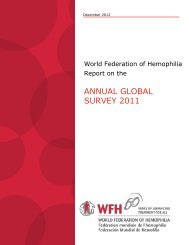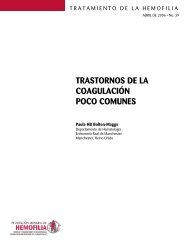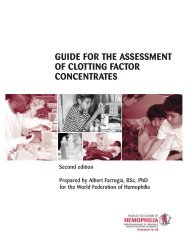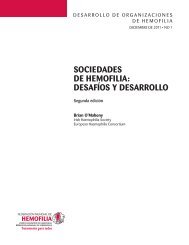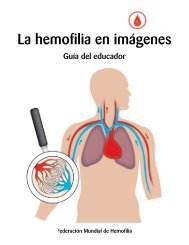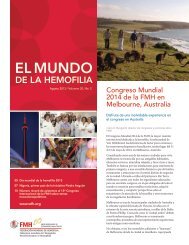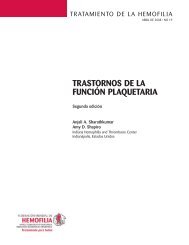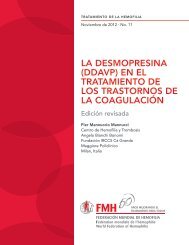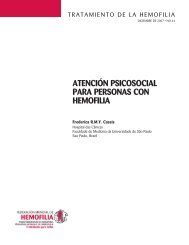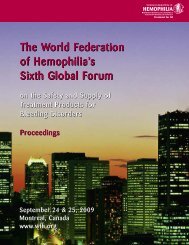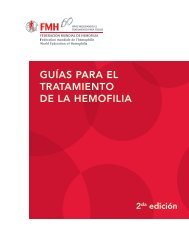What Is von Willebrand Disease? - World Federation of Hemophilia
What Is von Willebrand Disease? - World Federation of Hemophilia
What Is von Willebrand Disease? - World Federation of Hemophilia
Create successful ePaper yourself
Turn your PDF publications into a flip-book with our unique Google optimized e-Paper software.
<strong>What</strong> is <strong>von</strong> <strong>Willebrand</strong>disease?
Published by the <strong>World</strong> <strong>Federation</strong> <strong>of</strong> <strong>Hemophilia</strong> (WFH)© <strong>World</strong> <strong>Federation</strong> <strong>of</strong> <strong>Hemophilia</strong>, 2008The WFH encourages redistribution <strong>of</strong> its publications foreducational purposes by not-for-pr<strong>of</strong>it hemophilia organizations.To obtain permission to reprint, redistribute, or translate thispublication, please contact the Communications Department at theaddress below.This publication is accessible from the WFH website at www.wfh.org.Additional print copies can be ordered from:<strong>World</strong> <strong>Federation</strong> <strong>of</strong> <strong>Hemophilia</strong>1425 René Lévesque Boulevard West, Suite 1010Montréal, Québec H3G 1T7CANADATel.: (514) 875-7944Fax: (514) 875-8916E-mail: wfh@wfh.org
<strong>What</strong> is <strong>von</strong> <strong>Willebrand</strong> disease (VWD)?<strong>von</strong> <strong>Willebrand</strong> disease (VWD) is a bleeding disorder. Peoplewith VWD have a problem with a protein in their blood that helpscontrol bleeding. They do not have enough <strong>of</strong> the protein or itdoes not work the way it should. It takes longer for blood to clotand for bleeding to stop.There are different types <strong>of</strong> VWD. All are caused by a problem withthe <strong>von</strong> <strong>Willebrand</strong> factor (VWF) protein. When a blood vessel isinjured and bleeding occurs, VWF helps cells in the blood, calledplatelets, mesh together and form a clot to stop the bleeding.VWD is the most common bleeding disorder that people have. Itaffects both males and females. VWD is generally less severe thanother bleeding disorders. Many people with VWD may not knowthat they have the disorder because their bleeding symptoms arevery mild. For most people with VWD, the disorder causes little orno disruption to their lives except when there is a serious injuryor need for surgery. However, with all forms <strong>of</strong> VWD, there can bebleeding problems.How do people get VWD?VWD is usually inherited. It is passed down through the genesfrom either parent to a child <strong>of</strong> either sex. Sometimes there is evidence<strong>of</strong> a family history <strong>of</strong> bleeding problems. However, bleedingsymptoms can vary a lot within a family. Sometimes there is n<strong>of</strong>amily history and VWD occurs due to a spontaneous change inthe VWD gene before the baby is born.<strong>What</strong> is <strong>von</strong> <strong>Willebrand</strong> disease? 1
<strong>What</strong> are the symptoms <strong>of</strong> VWD?The main symptoms <strong>of</strong> VWD are:• easy bruising• frequent or prolonged nose bleeds• bleeding from gums• prolonged bleeding from minor cuts• heavy or prolonged menstrual bleeding• bleeding in the upper and lower gastrointestinal tract• prolonged bleeding following injury, surgery, dental work,or childbirthMany people with VWD have few or no symptoms. People withmore serious VWD may have more bleeding problems. Symptomscan also change over time. Sometimes VWD is discovered onlywhen there is heavy bleeding after a serious accident or a dental orsurgical procedure.More women than men show symptoms <strong>of</strong> VWD. Women withVWD <strong>of</strong>ten bleed more or longer than normal with menstruationand following childbirth. Some women with VWD have a lot <strong>of</strong>menstrual pain or irregular menstruation.Blood type can play a role. People with Type O blood <strong>of</strong>ten havelower levels <strong>of</strong> VWF than people with Types A, B, or AB. This meanspeople with VWD and Type O blood may have more problemswith bleeding.2 <strong>What</strong> is <strong>von</strong> <strong>Willebrand</strong> disease?
Inheritance <strong>of</strong> <strong>von</strong> <strong>Willebrand</strong> disease<strong>What</strong> is <strong>von</strong> <strong>Willebrand</strong> disease? 3
How is VWD diagnosed?VWD is not easy to diagnose. People who think they have a bleedingproblem should see a hematologist who specializes in bleedingdisorders. Proper tests can be done at a bleeding disorders treatmentcentre. Since the VWF protein has more than one function,more than one lab test should be used to diagnose VWD.Laboratory testing for VWD is also difficult. VWD cannot bediagnosed with routine blood tests. Testing involves measuringa person’s level and activity <strong>of</strong> VWF, and that <strong>of</strong> another bloodclotting protein, factor VIII (FVIII). Testing is <strong>of</strong>ten repeatedbecause a person’s VWF and FVIII levels can vary at different times.Different types <strong>of</strong> VWDThere are three main types <strong>of</strong> VWD. Within each type <strong>of</strong> VWD, thedisorder can be mild, moderate, or severe. Bleeding symptoms canbe quite variable within each type depending in part on the VWFactivity. It is important to know which type <strong>of</strong> VWD a person has,because treatment is different for each type.Type 1 VWD is the most common form. People with Type 1 VWDhave lower than normal levels <strong>of</strong> VWF. Symptoms are usually verymild. Still, it is possible for someone with Type 1 VWD to haveserious bleeding.Type 2 VWD involves a defect in the VWF structure. The VWFprotein does not work properly, causing lower than normal VWFactivity. There are different Type 2 VWD defects. Symptoms areusually moderate.Type 3 VWD is usually the most serious form. People with Type3 VWD have very little or no VWF. Symptoms are more severe.People with Type 3 VWD can have bleeding into muscles andjoints, sometimes without injury.4 <strong>What</strong> is <strong>von</strong> <strong>Willebrand</strong> disease?
How is VWD treated?VWD can be treated with a synthetic drug called desmopressin, aclotting factor concentrate that contains VWF, or other drugs thathelp control bleeding. The type <strong>of</strong> treatment depends in part onthe type <strong>of</strong> VWD a person has. People with mild forms <strong>of</strong> VWD<strong>of</strong>ten do not require treatment for the disorder except for surgeryor dental work.Desmopressin is generally effective for treating Type 1 VWD, andhelps prevent or treat bleeding in some forms <strong>of</strong> Type 2 VWD.It is used to control bleeding in an emergency or during surgery. Itcan be injected or taken by nasal spray, and raises VWF and FVIIIlevels to help blood clot. Desmopressin does not work for everyone.A doctor needs to do tests to find out if an individual responds tothe drug. Ideally, tests should be done before treatment is needed.Factor concentrates are used when desmopressin is not effectiveor when there is a high risk <strong>of</strong> major bleeding. Factor concentratescontain VWF and FVIII. This is the preferred treatment for Type3 VWD, most forms <strong>of</strong> Type 2 VWD, and for serious bleeding ormajor surgery in all types <strong>of</strong> VWD.Bleeding in mucous membranes (inside the nose, mouth, intestines,or womb) can be controlled by drugs such as tranexamic acid(Cyklokapron), aminocaproic acid (Amicar), or by fibrin glue.However, these products are used to maintain a clot and do notactually help form a clot.Hormone treatment, such as oral contraceptives, helps increaseVWF and FVIII levels and control menstrual bleeding. If hormonetreatment is not prescribed, antifibrinolytic agents may be effectivefor treating heavy menstruation.These treatments may have side effects, so people with VWD shouldtalk to their physician about possible side effects <strong>of</strong> treatment.<strong>What</strong> is <strong>von</strong> <strong>Willebrand</strong> disease? 5
<strong>Is</strong>sues for girls and women with VWDWomen with VWD tend to have more symptoms than men because<strong>of</strong> menstruation and childbirth. Girls may have especially heavybleeding when they begin to menstruate. Women with VWD <strong>of</strong>tenhave heavier and/or longer menstrual flow. This heavier menstrualflow can cause anemia (lower iron in red blood cells, resultingin weakness and fatigue). Women with VWD should be checkedregularly for anemia.A woman with VWD should see an obstetrician as soon as shesuspects she is pregnant. The obstetrician should work witha bleeding disorders treatment centre to provide the best careduring the pregnancy and childbirth. During pregnancy, womenexperience an increase in VWF and FVIII levels. This providesbetter protection from bleeding during delivery. However, afterdelivery, these clotting levels decrease and women with VWDmay then develop bleeding.Women with VWD entering menopause (end <strong>of</strong> menstruation,usually between the ages <strong>of</strong> 45 and 50) are at increased risk <strong>of</strong>unpredictable and heavy bleeding. It is important for a womanwith VWD to maintain a strong relationship with her gynecologistas she approaches menopause.6 <strong>What</strong> is <strong>von</strong> <strong>Willebrand</strong> disease?
Important points for people living with VWD• Carry information about your disorder, the treatment thathas been prescribed, and the name and telephone number <strong>of</strong>your physician or treatment centre. In emergencies, a medicalbracelet or other identification notifies healthcare personnel<strong>of</strong> your bleeding disorder.• Give schools information about VWD and how to handlesituations that may arise. The most common problemencountered at school is a nose bleed.• Register at a centre that specializes in diagnosis and treatment<strong>of</strong> bleeding disorders, as they are likely to <strong>of</strong>fer the beststandards <strong>of</strong> care and information.• Check all medications with your doctor. Some over-the-countermedications should be avoided because they interfere withclotting.• Exercise regularly to keep joints and muscles strong and stayin good health.• When travelling, find the addresses and telephone numbers <strong>of</strong>the bleeding disorders treatment centres at your destination(s)and bring the information with you.<strong>What</strong> is <strong>von</strong> <strong>Willebrand</strong> disease? 7
<strong>World</strong> <strong>Federation</strong> <strong>of</strong> <strong>Hemophilia</strong>1425 René Lévesque Boulevard West, Suite 1010Montréal, Québec H3G 1T7CANADATel.: (514) 875-7944Fax: (514) 875-8916E-mail: wfh@wfh.orgInternet: www.wfh.orgThis publication was made possible byunrestricted educational grants fromCSL Behring and Grifols.



